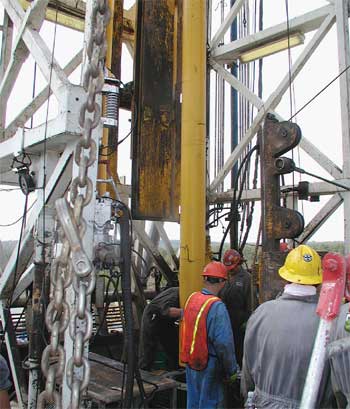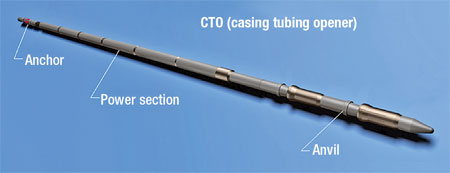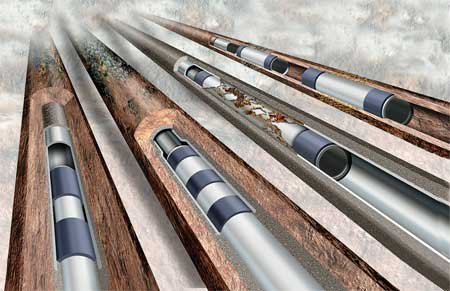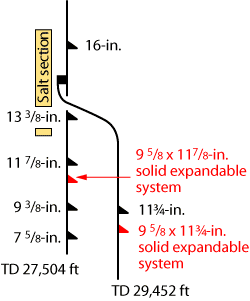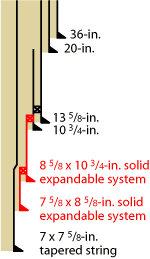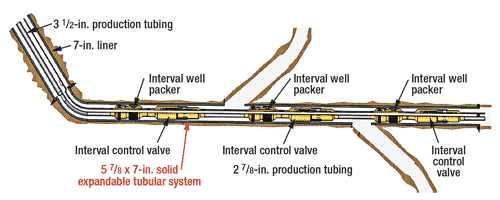What's new in expandable technology?
Five companies share experience and new applications for expandable systems.
OIL COUNTRY TUBULAR GOODSWhat’s new in expandable technology?Five companies share experience and new applications for expandable.Victor Schmidt, Drilling Engineering Editor and Kurt Abraham, Managing Editor Now in its fifth consecutive year, this World Oil focus on expandable technologies reviews how the industry is applying expandables to solve wellbore problems. The reader is encouraged to review our July issues from 2003 forward for the products applied and approaches the industry has taken, as it has explored the uses of expandable systems. This year, five companies provided recent applications of their systems to demonstrate how troublesome wellbore problems can be solved. The first vignette demonstrates the use of an expandable liner to extend a casing string. This is followed by a drilling application, using expandables to drill-with-liner before expanding them in place. A new tubing opener system has been developed with a multistage hydraulic power section. New expandables are also growing in diameter with sizes up to 18 in. x 22 in. Swelling shale zones are a common drilling problem that can be overcome by sealing-off the trouble zone with an openhole expansion system. This zone can later be cased and sealed with another expandable liner. The industry has found a wide range of uses for expandables such that a single size and tool type is no longer enough. One company has revamped its system and now offers four versions for specific applications to better solve the industry’s wellbore problems. Our final contributor provided recent case studies to demonstrate the range of applications for expandables to preserve hole diameter when liner becomes stuck, to maintain diameter as deeper hole segments are drilled by “nesting” expandable strings and by gaining control of water production in mature fields with openhole completions by casing with expandables. BAKER OIL TOOLS Monobore expandable liner extension system installed. For a number of years, the industry has sought to use monobore expandable liner extensions as an alternative to conventional casing designs. An expandable monobore liner extension enables the operator to drill deeper exploration and production wells with larger hole sizes at the reservoir. As a contingency plan, the system allows the operator to isolate reactive shale zones, subsalt environments, low-fracture-gradient formations or other drilling situations without reducing the casing and subsequent drilled-hole size into the reservoir. This solid expandable system is the product of collaboration between Baker Oil Tools and BP. A monobore expandable liner extension system was successfully installed in a commercial well in southeast Oklahoma. The linEXX* system included running an RC9-R* recess shoe on the 9 5/8-in. parent casing string, FORMlock* expandable hanger/packer, 36 joints of 8.0-in. by 0.345-in. thickness wall, expandable liner and an RNX* guide shoe. The liner was expanded with the catEXX* expansion tool, Fig. 1.
The solid expandable system provides one-trip, top-down expansion to extend the 95/8-in. casing string, while maintaining the parent casing’s 8 1/2-in. ID. First, a contingency recess shoe was installed on the 9 5/8-in. parent casing at 2,588 ft. Expandable liner (1,514 ft of 8-in. liner) was run in the hole and located in the pre-installed recess shoe profile. In a single trip, the hanger and liner were expanded 18% to 8 5/8-in. nominal ID and 8 1/2-in. drift ID through their full length and the guide shoe was retrieved. The expanded liner was pressure-tested, the circulating sleeve was shifted open and the liner cemented using a K-1 cement retainer with returns through the recess shoe ports. The retainer and cement were then drilled out. Drilling continued at 4,020 ft with rotary steerable directional tools. Plans called for isolating the liner system with production casing before completing the well. TIW X-PAK ELH system features larger sizes, spinoff CTO tool. TIW continues development of the X-Pak ELH System* with 35 systems deployed in wells to date. One of the primary design goals with this system has been a focus on drilling with liner. Eight systems have been used for liner drilling of both cement plugs and new formation. Intervals drilled range from 900 ft to 2,700 ft. System durability has been the key to successful liner drilling with the system. On a South Texas well for a major oil company, the operator lost returns while drilling conventionally. A cement plug was set across the entire openhole section and the decision was made to pick up the liner, drill out the cement plug and continue to TD. Before reaching the bottom of the cement plug, returns were lost again. The operator decided to attempt to squeeze with the liner and ELH system in the hole. The squeeze was performed and the liner pulled up into cased hole to allow cure time for the squeeze. Drilling resumed and again loss circulation occurred. Drilling continued with loss returns to TD. A cement job was completed and the expandable hanger set. The lap was successfully tested with 3,500 psi. The total operational time with the expandable system in the hole was four days with about 70 hrs rotating time using the liner. On a recent drilling-with-liner field trial with a major operator, the objective was to drill with the liner at 67° inclination. A total of 2,700 ft of new formation was drilled over a 5 1/2 day period, during which the liner was pulled from the hole and inspected several times. The system proved durable for long-interval drilling. The new development focus has been on large diameter ELH systems for 11 ¾-in. to 26-in liner sizes. Testing has been completed on 113/4 x 13 5/8-in., 14 x 16-in., 16 x 20-in. and 18 x 22-in. sizes. There are currently several field trials pending that should be completed by mid-2007. One of the design goals was to provide high-load capability for long heavy liners. This was accomplished after the 14 x 16-in. size tested successfully with a 1.2 million lb load test and the 18 x 22-in. size load-tested to 1.6 million lb. To date, the system has met or exceeded all design goals. TIW, with assistance from several major operators, continues field testing expandable systems’ capabilities. New technology has evolved from the ELH system work. The Casing-Tubing Opener (CTO)* is designed to open collapsed casing or tubing. This system uses a hydraulic multistage power section, similar to the setting tool for the liner system. A mechanical set anchor is added above the power section with a staged expansion anvil below, Fig. 2.
The tool is run in the casing to the collapse point and the anchor is set with rotation. Hydraulic pressure activates the power section, which drives the anvil through the collapsed pipe. Successful testing has been completed on 5 1/2-in., 17 ppf, L-80 pipe. A total of 90 ft of collapsed 5 1/2-in. casing was successfully opened during testing at TIW’s research and development facility and an additional 85 ft was successfully opened in a test well. The tool’s first field deployment is scheduled for offshore West Africa with a major operator in late July 2007. HALLIBURTON Expandable completion system isolates shale sections. The PoroFlex* expandable completion system from Halliburton isolates shale sections in complex reservoirs. Fig. 3. Combining expandable filtration material, perforated and solid expandable basepipe, and annular barrier technology, it allows for robust isolation of shale intervals. The large post-expansion ID and circular profile accommodate both packer, SmartWell* or multi-zone installation, to produce cased hole functionality in an openhole environment.
The variable expansion system allows a post-expansion OD variation of about one inch per linear foot and can it can be run through seal bores or tight formations without making a round trip. While the diameter can change, the expansion profile remains circular. The system uses a fixed cone to conduct the initial expansion, followed by a variable cone for final expansion. The variable cone can change diameter based on the resistance encountered - the higher the expansion resistance, the lower the expansion ratio; the lower the resistance, the higher the expansion ratio. The system reaches a maximum 8.8-in. screen OD and provides rapid response for the varying expansion. Contingency release and internal filtration mechanisms are incorporated in the design. The system is available for 8½-in. open hole and 9 5/8-in. cased hole applications and will be deployed in late 2007. WEATHERFORD Earlier this year, Weatherford International Ltd. launched its new MetalSkin* Solid Expandable Systems for open and cased hole applications. This is part of the firm’s continued effort to reduce installation risks for solid expandables, and make many of today’s capital-intensive wells economically viable. Astute readers will recognize the MetalSkin name and ask how this differs from the original ESS MetalSkin system profiled in the pages of World Oil two years ago (July 2005). Essentially, the original system was an attempt at a one-size-fits-all solution. However, the firm’s engineers found that this did not necessarily work for everybody or suit all needs. Accordingly, they tore the system down to its components and re-developed it into the four distinct systems (Fig. 4) that debuted in February 2007. These include: 1) openhole liner; 2) monobore openhole liner; 3) cased-hole liner; and 4) monobore openhole clad. Most of these systems can be used for multiple applications, to address both pre-planned and remedial well construction challenges.
“Solid tubular expansion is considered to be one of the most important enabling technologies for the future of the oil and gas industry,” said Pat York, Weatherford’s director of Commercialization and Marketing for the Solid Expandables business unit. “We could have come into the market pretty quickly after acquiring the rights for a cone-based expandable system from Shell. But the industry had some concerns, and first we wanted to make some refinements to address those concerns - whether real or perceived.” At its most basic, the goal of the solid expandable systems is to reduce installation risks, while driving down construction and well repair costs and minimizing drilling hazards. However, there are subtle differences in the problems targeted by the individual system versions. For instance, the openhole liner systems are intended to maximize a field’s ROI by reducing construction costs with slimmer tophole casing sections while upsizing the completion. This allows the operator to isolate problem zones and drill ahead. The system deals with lost-circulation zones, overpressured formations, zones with shallow flows, and premature casing sets. By comparison, the monobore open-hole liner systems allow operators to gain an extra string of casing with no loss of hole size. One can drill out with the same size bit, and remediate drilling hazards, such as lost circulation and over-pressured zones. An oversized shoe is run into the hole with the previous string of casing, and the liner extension is then run to total depth and expanded back into the oversized shoe. This technique provides a string with the same diameter as the one above it. In the case of the cased-hole liner systems, their purpose is to answer mature-field challenges by permanently repairing corroded or parted casing. Elastomer seal bands are designed to give more reliable zonal isolation than cement squeezes. In addition, they don’t significantly reduce well ID, as do scab liners. Finally, the monobore openhole clad systems selectively isolate trouble zones as they are encountered, so that drilling can continue without sacrificing hole size. After the clad is expanded to seal the zone, another clad can be passed through it to treat the next trouble zone that is encountered. The system reportedly provides a much faster, more cost-efficient method than pumping thicker muds and cement in an attempt to seal a formation or stabilize a sloughing formation. The solid steel barrier keeps the formation from falling in and fluid from flowing out. Significant downhole testing has been completed to date. On Feb. 14, 2007, about 1,000 ft of the 11¾-in. x 13 3/8-in. monobore openhole liner was successfully installed in a test well. In addition, an expandable cased-hole liner was recently installed for a major operator in the Caspian Sea to remediate a casing leak. This high-pressure gas well is one of the world’s more prolific producers, but it was shut-in, due to a leak needing remediation. Using the expandable cased-hole liner, the well is now producing at a rate in excess of 150 MMcfgd and 12,000 bcpd. The well’s flowrate was scheduled to be increased to its full capacity over a period of several weeks. “Our ultimate goal is to move solid expandables from being a risky contingency into the mainstream, where operators actually plan a system into their well,” said York. ENVENTURE Continued uses for SET* technology. Enventure Global Technology presented several uses for its Solid Expandable Tubular (SET)* system in recent professional papers. EGT has had success using the system to overcome stuck-casing problems, preserving hole diameter by “nesting” expandable tubulars and by reworking openhole completions for drilling laterals. A lost circulation zone in a deepwater well created problems for a major GOM operator.1 The zone occurred from 20,300 - 20,635 ft below a salt mass and prevented drilling because of pore-pressure regression. Liner (11 7/8 in., 71.8 lb) was run to 21,470 ft, but could not reach the planned 23,000-ft depth. It became stuck at 20,190 ft, so was hung and cemented there. Then, a 9 5/8 x 11 7/8-in. solid expandable tubular system was run to 21,442, restoring the original underreamed hole section, saving the drilled hole. After the liner was cemented and expanded, the well was drilled to a 27,504-ft TD. Later, the hole was sidetracked, drilled to 29,452 ft and cased, using a 9 7/8 x 11¾-in. final hole section, Fig. 5.
On a different GOM deepwater directional well the operator was sidetracking the hole and needed an additional casing string to reach the objective.1 The well was drilled at 41° from vertical and ended at 71°. By running 6,500 ft of 8 5/8-in. x 10¾-in. expandable tubulars, the intermediate section was extended to 15,766 ft. After additional drilling, a second 7 5/8 x 8 5/8-in. openhole expandable system was “nested” with the first extending the previous system’s shoe, Fig. 6. In total, the well had almost 10,000 ft of solid expandable tubulars installed.
Mature basins present new opportunities, as well as technological challenges. Operators must increase recovery factors over the long term, while manage production decline in the short term. Solid expandable systems are helping operators revitalize wells in mature fields that were drilled, evaluated and completed many years ago and developed with older techniques. A Middle Eastern operator had developed one of its fields using openhole, multi-lateral completions in long-reach horizontal wells. Water production problems and the inability to re-enter openhole sidetracks led to the use of solid expandable tubulars and intelligent well technology to control the wells. The operator transformed a horizontal well into a tri-lateral forked well.2 The main bore was underreamed, then a 5 1/2 in. expandable liner was run in the hole and hydraulically expanded. After a cement retainer was set, a 5¼-in. OD whipstock was run and set inside the liner. A casing window was milled, so that a 5½-in. directional drilling assembly could drill a lateral. The whipstock was retrieved and a retrievable plug was set. A new whipstock was run and oriented on top of the plug, then a second lateral was drilled with the 5½-in. assembly. This lateral reached out better than expected, to 7,340 ft. The equipment was retrieved and the float shoe was drilled-out in the expanded liner. Lastly, an intelligent completion system was installed to control production flow from the new lateraals, Fig. 7. After the workover, more than 18,000 ft was drilled through the reservoir with over 11,000 ft opened by the two laterals drilled out of the expandable liner.
The well was producing 1.5 MM bopd with 15% water cut before the workover. Once the work was completed, the well flowed at 6.0 MM bopd with 6% watercut, recovering workover costs in 10 days. Adding reserves from mature fields is recognized as a low risk way to add reserves. By using existing infrastructure better and opening productive zones using solid expandable tubulars, workovers can become a profitable source of new production. Click here for a complete list of World Oil’s annual expandable technology reports. LITERATURE CITED
|
- Coiled tubing drilling’s role in the energy transition (March 2024)
- Using data to create new completion efficiencies (February 2024)
- Digital tool kit enhances real-time decision-making to improve drilling efficiency and performance (February 2024)
- E&P outside the U.S. maintains a disciplined pace (February 2024)
- U.S. operators reduce activity as crude prices plunge (February 2024)
- Drilling advances (January 2024)

